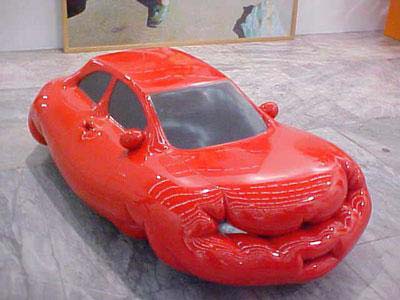Barabara Eichorn
Otto Zitko
Adriana Czernin
Johanna Kandl
Heimo Zoberning
Peter Kogler
Walter Obholzer
Lois Weinberger
Florian Pumhösl
Constanze Ruhm
Svetlana Heger
Plamen Dejanov
Franz West
Erwin Wurm
Hans Schabus
25/5/2002
Uncommon Denominator
Mass MoCA, North Adams
New Art from Vienna. More than 70 works by 14 individuals and one group in a range of media such as painting, sculpture and performance art. The exhibition concentrates on work created in the last five years, drawing from artists who vary in age, and including those whose reputations are only just emerging alongside others who have already achieved wider notoriety throughout Europe.

Perhaps no city in Europe today rivals Vienna for the
vibrancy and complexity of its emerging arts scene. Vienna
is the home of a lively, provocative group of artists who
are surprisingly little known in the United States, but
whose engaging and challenging works recall the city's
historic role as home to some of the finest art and artists
of the last century - and who continue the Viennese
tradition of challenging established artistic forms with wit,
craft, and innuendo.
In 2002, MASS MoCA (Massachusetts Museum of
Contemporary Art) is spotlighting these artists with a major
exhibition, Uncommon Denominator: New Art from Vienna
which presents more than 70 works by 14 individuals and
one group in a range of media such as painting, sculpture,
and performance art. The exhibition, which will fill virtually
all of the museum's main gallery building, will be on view
through March 2003.
Lush paintings and drawings, taut psychological
explorations, and witty conceptual works in this exhibition
amplify and challenge historic Viennese art forms. The
artists in Uncommon Denominator are "Viennese" in the
broadest sense: several came originally from eastern
Europe, from cities that were once part of the
Austro-Hungarian Empire, and some see Vienna as a
temporary home. The political transformations in Europe
over the last two decades have moved Vienna from the
geographic fringe of Western Europe (east of Prague, it
was the easternmost Western capital) to the center of a
united Europe, as it was at the beginning of the 20th
century. The style and occasionally the political content of
this work point to Vienna's pivotal position between east
and west.
Uncommon Denominator presents recent work under three
broad categories, though most of these artists slide fluidly
among them. The exhibition concentrates on work created
in the last five years, drawing from artists who vary in age,
and including those whose reputations are only just
emerging alongside others who have already achieved
wider notoriety throughout Europe. Furthermore, rather
than pursuing a broad strategy of inclusion, Uncommon
Denominator presents more works - 70 - by fewer artists.
The categories include:
The Tradition of Painting
At a time when painting struggles to hold its critical ground
on the international scene, rich, beautiful canvases are
painted in refreshingly large numbers in Vienna and are
linked through the academy to a century-old tradition of
painting and draftsmanship. In Herbert Brandl's expansive,
color-saturated canvases, the suggestion of a landscape
hovering just out of reach, Turner lurks, but so does
Kokoschka. Generous, sensual, intelligent painting of this
quality comes as a shock. Barabara Eichorn distills the
tortured line and psychic fervor of Egon Schiele's
century-old figures; her large, spare figure drawings are
equally intense, but cooler, more interior and restrained.
Otto Zitko expands line and gesture to architectural scale
with large, dynamic canvasses that deconstruct space and
record movement. Adriana Czernin, born in Sofia, Bulgaria,
reworks Gustav Klimt's legacy in her beautiful, disturbing
drawings and videos, while Johanna Kandl tempers the
political questions posed in her paintings with deft drawing
and striking use of color. In every case, the craftsmanship
and assertive beauty of these works testifies to the strong
tradition of the art academies in Vienna. An emphasis on
the making of paintings and drawings that appeal to the
eye never became anachronistic in this city.
Body/Performance
The legacy of Actionism can be clearly seen in Vienna in
the enduring fascination with performance and the body -
both that of the artist and that of the viewer. Actionism,
the 1960s art movement which responded to the
occupation and devastation of Vienna during the World
Wars, focused on "actions" (similar to New York's
"happenings") that were notorious for their often quite
brutal and blood-infused content. Franz West's Fitting
Pieces made of gesso require that the viewer contort his
body to experience the work. (West's longstanding
emphasis on collaboration with other artists is another
peculiarly Viennese trait.) Erwin Wurm has used his own
body as sculptural material, as documented in the
photographs Me and Me Fat, and has ascribed human
characteristics to an actual car, the fleshy pink Fat Car.
Hans Schabus is the only performer in his videos, whether
digging a hole in the forests of Corinthia or being pursued
by his doppelganger as he works in his studio.
Design as Concept
Throughout the 20th century design has had pride of place
in Viennese art, and the centrality of design can be clearly
seen in the conceptual work of the 1990s and beyond.
Heimo Zoberning, a leading conceptual artist, makes
artworks that slide into architecture and exhibition design.
Peter Kogler and Walter Obholzer have pushed their
separate investigations of pattern and decoration into
strikingly contrasting positions. Lois Weinberger finds apt
metaphors for social conditions in garden design. The
political bent of Weinberger's project can be found also in
Florian Pumhösl's video installations, which query the role
of colonialist architecture in Africa. Constanze Ruhm shares
Pumhösl's interest in architecture, but for her this interest
arises from film theory. Czech-born Svetlana Heger and
Bulgarian-born Plamen Dejanov work with Western luxury
consumer products, with an ironic wide-eyed enthusiasm
only Eastern Europeans could bring to the subject.
Image: Erwin Wurm
Massachusetts Museum of Contemporary Art
87 Marshall Street North Adams, Massachusetts 01247
Gallery hours: 11am-5 pm Weds-Mon (closed Tuesdays)



